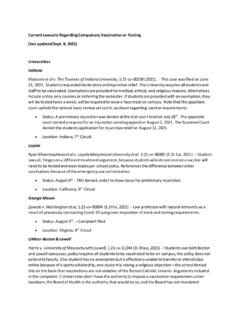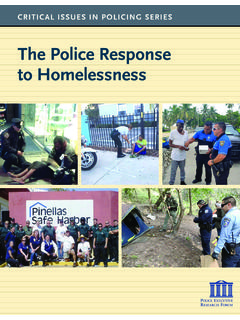Transcription of Understanding Your Local Eviction Landscape - nlc.org
1 Understanding Your Local Eviction Landscape : A WORKSHEET FOR CITY OFFICIALS. To develop an effective, data-driven, HOW TO USE THIS WORKSHEET. human-centered approach to preventing This worksheet is intended to guide city officials evictions, Local governments should think and municipal staff through the process of holistically about who they serve. What is defining and documenting their Local Eviction the full context for those facing Eviction ? Landscape . Users of this resource are encouraged Who is at high-risk of Eviction , and why? to engage various city departments and What data is necessary to reveal the community partners in answering the questions listed here, step-by-step. needs of those impacted by evictions? Some of the requested information and statistics Beyond the necessary task of collecting may be available through the municipality's own and analyzing data regarding the data collection efforts, while others may be individuals facing Eviction , municipalities identified through the public data sets suggested are in a unique position to holistically at the end of this worksheet.
2 Additionally, answers understand an Eviction crisis by to some questions may not be available for certain municipalities due to limited access to identifying root causes and patterns data in that case, this resource can serve as a related to their Local Eviction Landscape . way to identify gaps in accessible information, Doing so will enable cities, towns and which can inform future data collection efforts. villages to more successfully target By considering these questions about the causes, services to those households and scope and disproportionate impacts of Eviction individuals of the greatest need, and proceedings, Local governments and community deploy funding toward policies and stakeholders will be better equipped to develop practices that are appropriate based on and implement targeted policy solutions. the Local context. The Scope of Your Local Eviction Crisis 1. What is the Local Eviction filing rate? (Number of evictions filed per 100 renter households).
3 2. How many evictions are executed annually? 3. Where do evictions most frequently take place? ( , At the neighborhood, ZIP code, census tract, or census block level). 1. 2. 3. 4. 5. 4. What percentage of Eviction filings are based on nonpayment of rent? 5. What are the other top reasons cited in Eviction filings? 1. 2. 3. 6. What data is being collected on both formal and informal evictions in your community? What organizations or government entities are collecting it, and how accessible is it? 7. How is racial equity being taken into account during the data collection and analysis process? NATIONAL LEAGUE OF CITIES | 02. Your Landlord Community 8. What share of Local units are managed by large scale property managers? 9. What percentage of Local units are managed by mom and pop landlords with 10 or fewer units? 10. What economic burdens do Local landlords face, such as mortgages, property taxes and maintenance requirements? 11. What financial assistance programs are available to landlords facing loss of income or foreclosure?
4 12. Are there trends in who frequently files for Eviction ? If so, who are these serial evictors ? ( , specific leasing companies or landlords). Your Tenant Community 13. What is the demographic makeup of renters and renter households in your community? a. Breakdown by race Percent American Indian and Alaskan Native Percent Asian Percent Black Percent Hispanic/Latino Percent Native Hawaiian or Pacific Islander Percent White Percent Two or More Races Other NATIONAL LEAGUE OF CITIES | 03. b. Average age of renters or share of renter households by age group c. Percentage of non-native English speakers d. Top languages spoken by percentage of population 1. 2. 3. e. Average household size 14. Who is most at risk of Eviction ? Relevant factors may include race and/or ethnicity, language, immigration status, household income or employment status, family size, incarceration history and neighborhood. 15. What percentage of tenants have faced an Eviction at least once? 16. What share have faced an Eviction two or more times?
5 17. For Eviction filings based on non-payment of rent, what is the average amount owed? Your Economic & Other Drivers of Evictions RECOMMENDATION: To gain a more comprehensive Understanding of the impact of risk factors based on tenant demographics and economic factors, disaggregate this data by race and/or ethnicity. 18. What is the median gross rent? 19. What is the median household income? 20. On average, what percentage of household income do renters spend on housing? 21. What percentage of renters spend more than 30 percent of their income on housing and are therefore considered cost-burdened? NATIONAL LEAGUE OF CITIES | 04. 22. What is the rental vacancy rate? 23. What is the Local employment rate, and what are the top employment industries? 24. What is the Local poverty rate? 25. What additional housing is needed by AMI group or unit size? ( , more affordable housing units of a certain size, multi-family homes, supportive housing). Your Local Court & Housing Policy Landscape 26.
6 What barriers or incentives are built into your court policies related to evictions? ( , fees associated with filing, requirements to file Eviction notices with the city, mandated mediation). 27. What is the Local judicial sentiment and Understanding of evictions and Eviction prevention programs ? 28. What is the timeline and process associated with evictions, from the moment of filing through expulsion from a unit? Learn more about the phases of the Eviction process from NATIONAL LEAGUE OF CITIES | 05. 29. What legal protections are in place at the state, county or Local level related to landlord and tenant litigation? ( , Just Cause Eviction laws, right to counsel programs ). 30. Is there an Eviction data sharing agreement in place between the court and city officials? Your Eviction Prevention programs & Community Partners 31. What Local stakeholders are involved in the process of filing, processing or carrying out an Eviction ? 32. What prevention programs and supports are available through government agencies such as state, Local and county departments and community partners, and how are these programs funded?
7 Be sure to consider programs that serve both landlords and tenants. ( , emergency rental assistance programs or utility assistance, Eviction diversion programs , Eviction mediation services, legal aid, resource hotlines, housing navigators). NATIONAL LEAGUE OF CITIES | 06. 33. How do the available prevention programs and supports center racial and gender equity to ensure those disproportionately impacted are being served? 34. What Local stakeholders are involved in Eviction prevention work? 35. What types of individuals or households are not being served by existing Eviction prevention programs ? What are the gaps? 36. What do the Local demographic, geographic and economic factors indicate about how Eviction prevention should be tackled? NATIONAL LEAGUE OF CITIES | 07. Suggested Data Sources The index employs data from the ACS, the Urban Institute, and the Department of Housing and Urban Development's Comprehensive Housing If you do not have access to municipal data Affordability Strategy dataset.
8 To learn more sources that would answer the key questions about which specific data tables were employed and how each dataset was weighted to create the outlined, consider using the data sources listed index or to access the underlying data, see the here to inform your responses for this worksheet. Index's Technical Appendix. CENSUS BUREAU DATA AND. LEGAL SERVICES CORPORATION. RELATED TOOLS. The Legal Services Corporation (LSC) provides The American Community Survey (ACS). access to multi-year trend data on Eviction filings This ongoing survey from the Census Bureau for 1,054 counties in 24 states across the United provides information about america 's changing States. Note that data is only available at the state population, housing and workforce. and county level. Only 24 states are represented Relevant information collected includes: the in this data set. demographic makeup of renters, top non-English PRINCETON Eviction LAB. languages spoken, median household income, Local (un)employment rates and more.
9 More The Princeton Eviction Lab developed the granular data ( , median gross rent by race/ Eviction Tracking System, a multi-use, open- ethnicity) is also available from the ACS Public source and real time Eviction tracking system. Use Microdata Sample (PUMS) for certain Note that the system is currently tracking 6 states localities. and 31 cities. Available data can be downloaded here. The Household Pulse Survey Historical data (2000-2016) for states and The Census Bureau began to collect and counties is available here. make publicly available this data displaying the social and economic impacts of the COVID-19 RELEVANT COURTS. pandemic upon households in April 2020. The accessibility of data available from court Relevant information collected includes: the processed Eviction filings varies significantly payment status of last month's rent/mortgage for across localities. City leaders should pursue close renter and owner-occupied housing units, partnerships with the relevant court to ensure confidence in the ability to make next month's efficient sharing of data and alignment on data payment, the likelihood of residents having to collection methodologies for ease of analysis.
10 Leave their home due to a foreclosure or Eviction , Clerks of the court are often a good first point of and more. contact for this. RECOMMENDATION: Consider developing a The Emergency Rental Assistance Priority Index memorandum of Understanding to outline the The Urban Institute developed a tool that data sharing agreement with courts and/or estimates the level of need for emergency rental Local organizations. assistance dollars per census tract across each Local ORGANIZATIONS. state based on an index that utilizes housing instability, COVID-19 and equity-based variables to Many Local organizations ( , tenants' rights determine where there is an increased risk of organizations) collect and in some cases publicize housing instability, notably in areas with a high Eviction data. City leaders should connect with concentration of extremely low-income renters. their Local network of Eviction prevention stakeholders to see who may be gathering Eviction -related data. This resource was developed by National League of Cities and the Stanford Legal Design Lab based on work with the Eviction Prevention Learning Lab.








